McGill at the top of the world
As the concept of climate change and global warming gathers steam in the public consciousness, our collective focus turns north, where images of crumbling ice shelves and scrawny polar bears serve as symbols of the havoc we’ve wrought. There are those among us, including the five McGill researchers featured on these two pages, whose interest in, and passion for, the Arctic, was kindled long before the winds of change blew alarmingly warm. For many, their personal Northern Passage took a circuitous route. There is a geologist-turned-archaeologist (James Savelle), an archaeologist-turned-cultural-geographer (George Wenzel) and a former designer of jet engines (Bruno Tremblay) who traded that relentless din for the absolute tranquility of Arctic sea ice. These are their stories, as different as snowflakes. – Neale McDevitt
Wayne Pollard, polar scholar
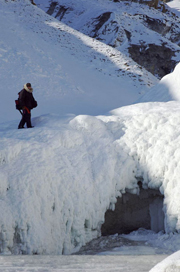
Geography professor and permafrost geomorphologist Wayne Pollard surveys the tundra on Axel Heiberg Island in the Arctic Ocean.
courtesy of DALE ANDERSEN
Shocked as we might be by the potential effects of global warming on the Arctic reality, it might take a thousand years and a thousand more degrees to diminish the mythology of polar exploration as a dangerous, often fatal attraction. For McGill geography professor Wayne Pollard, tales of parka-clad mansicles forever preserved after one wrong turn weren’t a deterrent.
“It’s just like winter camping. The conditions are harsh, but you’re prepared for them,” he said, adding, “I’ve always had a sense of adventure.”
Prof. Pollard’s field research may not be as dangerous as it would have been 100 years ago, but since 1975, first as an exploration geologist, then in his current vocation of permafrost geomorphologist, he has willingly lived and worked for several months of the year in what many still consider an extreme environment, the Arctic.
His research focuses on understanding the evolution of polar landscapes. In particular, the analysis of dynamic relationships between climate and terrestrial systems, including permafrost, ground ice and ground water. Prof. Pollard, who runs McGill’s Artic Research Station (MARS) outposts in Schefferville, Quebec and Axel Heiberg Island, Nunavut, said permafrost isn’t just a passive element.
Prof. Pollard is helping to develop models for predicting permafrost-linked erosion and the impacts it might have on northern people, including any insight it provides into global climate change patterns. “The practical implications of my research are linked to human activities in the North. Permafrost plays a major role in all forms of human activity, particularly in construction or resource extraction and exploration,” he said.
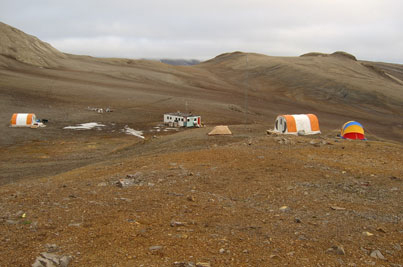
Wayne Pollard runs MARS, the McGill Arctic Research Station on Axel Heiberg Island, Nunavut , shown above in July2006. MARS is one of the longest operating seasonal field research facilities in the high Arctic.
courtesy of Thomas Niederberger
While some people find the isolation of Arctic research psychologically trying, many thrive on the challenge, he said. And most don’t mind the holiday from email, television and newspapers. “Your curiosity diminishes after a while. I think that’s part of the psychology. When you’re North and the Stanley Cup’s going on, you get the odd guy wanting to know the score, but after a while they stop asking.”
Echoes of the past
If it weren’t for the Arctic, James Savelle’s life would have turned out entirely different. First coming north as a geology undergrad field assistant, Savelle was immediately struck by the natural beauty of the land and the mysterious allure of the prehistoric relics and settlements that dotted the region. “Because there is almost no soil development, sites that are 4,500 years old were sitting right in front of me, waiting to be explored,” he recalled.
Going on to get two degrees in geology, Savelle had nonetheless been bitten by the bug, working it so that most of his field work was done in the Arctic. “Finally, I asked myself if 20 years from now I would rather be examining rock formations or unearthing more about fascinating Arctic cultures?” Geology’s loss was archaeology’s gain.
Now an expert in the prehistoric Thule Inuit, Savelle said that the rise and fall of this whaling culture is proof that climate change is not just a contemporary issue.
“The Thule arrived in Canada’s Eastern Arctic some 1,000 years ago during a period of general warming that made conditions ripe for hunting bowhead whales during the summer weeks,” said Savelle. More than a source of food for the Thule, the bowhead occupied a central part of their culture and mythology. “Because there are essentially no trees to be found, houses were made of whale bones, often symbolically arranged so that you entered through an entrance made of bowhead skulls and mandibles—its mouth—and moved to the centre of the house supported by whale ribs so that you lived within the whale.
But 400-500 years ago, the whaling seasons grew increasingly short—the result of the onset of what has been termed “the little Ice Age.” Eventually the winter ice never or rarely thawed to any great extent, greatly limiting the bowhead’s summer range and predictability within the Arctic Islands . “Quite suddenly we simply lose almost all of the whaling communities in this region,” he said. While some experts believe that the Thule migrated south to integrate into non-whaling Inuit villages, Savelle thinks it would have been too difficult for communities already under stress from climate change to absorb additional populations. Instead, he speculates that the communities dwindled in size and eventually disappeared altogether, leaving nothing behind but the skeletons of their empty houses.
Exploring the universe one tiny world at a time
Lyle Whyte is a pioneer and a trailblazer—and not just because he braves the elements of the high Arctic’s Ellesmere Island to practice his science. That, although as rugged a laboratory as you’ll find on earth, has been done before. No, the new worlds Whyte is exploring are too small to be seen by the naked eye, embedded in the tiniest unexplored corners of the permafrost.
“Permafrost research is fascinating because almost no one else does it, partially because the working conditions can be pretty demanding ” said the Canadaian Research Chair in Environmental MicrobiologyBiology. “But if you are at all interested in micro organisms and that grow in very low temperatures, you’ve got to go to the coldest places on the planet.”
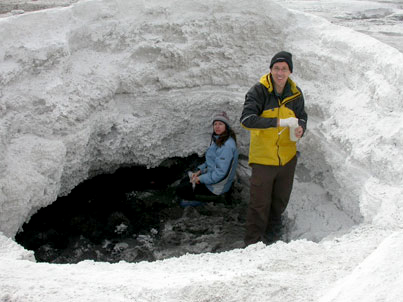
Surrounded by salt, PhD candidate Nancy Perreault and post-doc student Thomas Niederberger analyze the highly saline and very cold Lost Hammer Spring on Axel Heiberg Island.
courtesy of Lyle Whyte
Though miniscule in focus, the permafrost project has the potential to have an impact felt around the world and beyond. One research stream is examining the Pandora’s Box -like effect global warming could have on the permafrost. “It is projected that 90 percent of the top three metres of Northern Hemisphere permafrost will melt in the next 100 years. The fear is that as it melts, the organic carbon trapped in the permanfrost will be produce transformed or metabolized by permafrost microbes into significant quantities of greenhouse gasses, which will only accelerate the warming. Our job is to see what microbial activities will be triggered in our samples as they heat up.”
Whyte’s work is also of great interest to space agencies, the Canadian Space Agency funds his permafrost research, particularly with the discovery that large areas of Mars’ surface are covered water-saturated permafrost. If micro organisms can survive the high Arctic, could they thrive in the harsh climate of the Red Planet? “It’s impossible to say because we still don’t know what the low temperature limit of microbial life is and are only beginning to discover and characterize the viable bacteria inhabiting this very harsh permafrost environment.”
With the Holy Grail of space discovery—life on another planet—so tantalizingly close, future Mars landers will be fitted with drills to take core samples. When NASA scientists travel to the Canadian high Arctic to test their prototype robotic drill, Whyte joins them to ensure that the samples haven’t been compromised or contaminated. At the end, he’s left with large samples of permafrost. “Just a chunk of frozen dirt or ice to the technician working the drill,” laughed Whyte, “but to an Arctic microbiologist, it’s like Disneyland.”
From Brooklyn to Baffin Island
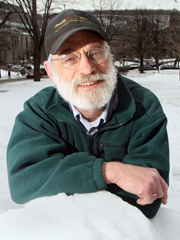
George Wenzel will examine women’s roles in the hunting economy
Owen Egan
It began 40 years ago, when George Wenzel was an undergraduate archaeology student looking to carve a niche for himself away from the southern meccas of the trowel and tweezer set.
Young and ambitious, he realized that the journals were already choked with articles on New Mexico’s Chaco Canyon but the Arctic was wide open.
A funny thing happened along the way to launching his narrative from Brooklyn Boy to great Arctic archaeologist.
“I found out I like living Inuit now more than I like the Inuit from the past,” he observed in his cramped Burnside Hall office.
“I mean the country is wonderful, but I wouldn’t be the recidivist that I am if it weren’t for the people.”
Wenzel became enamoured with the people of Clyde River, a Baffin Island community he first entered in 1971 and has been going back to every year since, studying the modern hunting-based economy while living and hunting with his…the word “friends” pops up frequently in places other researchers would have used “subjects.”
Behind his desk, a floor to ceiling collage of curled photographs of beaming Inuit faces at weddings, graduations and baptisms echoes the word over and over.
But global warming means longer hunts done from boats rather than on the relative safety of dry land.
“Everyone talks about winter storms, but it’s the summer storms that are the real killers because they catch people out in open water,” said Wenzel. Also melted away, the “exoticism” that first drew Wenzel; dog sleds and seal oil lamps have given way to snowmobiles and propane lanterns.
Hardest of all is the change in the social landscape.
“A lot of the people I used to travel with, friends who taught me language and other skills, they are gone too,” said Wenzel, looking back at the wall of smiles, caught forever in happy times.
The iceman cometh no more
Asked what was the coldest temperature he’s ever had to contend with, high-latitude researcher Bruno Tremblay, who regularly patrols the ice flows of the 80th parallel in open boats, snowmobiles and on foot, smiles. “Somewhere in the minus 40s—back home in Chicoutimi.”
Tremblay specializes in predictions, specifically predictions about climate change and the effects it will have on Arctic sea ice. Using predicted greenhouse gas emission trends designed by the Intergovernmental Panel on Climate Change, Tremblay and his team are able to simulate various climate scenarios on computer models. The news, as you might have guessed, isn’t good. “In the last 30 years there has been a trend in the Arctic of a decline of sea ice at the rate of eight percent per decade,” said Tremblay. “If you extrapolate that, we’ll have complete decline by 2100.”
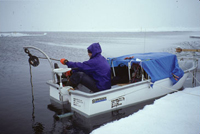
Bruno Tremblay measures temperature and salinity in the Beaufort Sea north of Alaska.
courtesy of Bruno Tremblay
However, plug in the rate of decline over the past decade, which has seen a marked acceleration, and Tremblay’s recent research, funded by NASA, predicts ice-free Arctic summers as early as 2040.
By now every grade schooler is aware that greenhouse gasses are one of the chief culprits driving climate change. What they don’t know, however, that once the atmospheric balance has been upset, it sets in motion a series of natural actions and reactions that only further us down that precipitous path.
“As the ice melts, it creates more open water,” explained Tremblay. “Where ice reflects sunlight, open water absorbs it, warms up and speeds up the process by melting the underside of the remaining ice.”
Surprisingly, even though he has a front row seat to the havoc being wrought on the great flows of Arctic sea ice, Tremblay’s overriding message is one of hope. “People have gone from ignoring the situation altogether to being too paralyzed to act,” said Tremblay. “Personally, I don’t think we’ve reached the point of no return. What we need now is for people to elect a government that isn’t afraid to take the hard decisions.”

